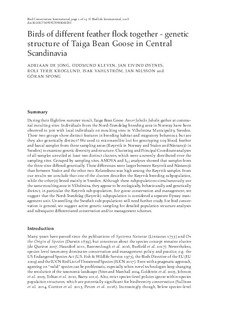Birds of different feather flock together - genetic structure of Taiga Bean Goose in Central Scandinavia
de Jong, Adriaan; Kleven, Oddmund; Østnes, Jan Eivind; Kroglund, Rolf Terje; Vahlström, Isak; Nilsson, Jan; Spong, Göran
Journal article, Peer reviewed
Accepted version

Åpne
Permanent lenke
http://hdl.handle.net/11250/2604951Utgivelsesdato
2018Metadata
Vis full innførselSamlinger
- Publikasjoner fra CRIStin - NINA [2364]
- Scientific publications [1392]
Originalversjon
10.1017/S0959270918000205Sammendrag
During their flightless summer moult, Taiga Bean Geese Anser fabalis fabalis gather at communal moulting sites. Individuals from the Nord-Trøndelag breeding area in Norway have been observed to join with local individuals on moulting sites in Vilhelmina Municipality, Sweden. These two groups show distinct features in breeding habitat and migratory behaviour, but are they also genetically distinct? We used 12 microsatellite loci for genotyping 109 blood, feather and faecal samples from three sampling areas (Røyrvik in Norway and Stalon and Nästansjö in Sweden) to examine genetic diversity and structure. Clustering and Principal Coordinate analyses of all samples unveiled at least two distinct clusters, which were unevenly distributed over the sampling sites. Grouped by sampling sites, AMOVA and FST analyses showed that samples from the three sites differed genetically. These differences were larger between Røyrvik and Nästansjö than between Stalon and the other two. Relatedness was high among the Røyrvik samples. From our results we conclude that one of the clusters describes the Røyrvik breeding subpopulation, while the other(s) breed mainly in Sweden. Although these subpopulations simultaneously use the same moulting area in Vilhelmina, they appear to be ecologically, behaviourally and genetically distinct, in particular the Røyrvik sub-population. For goose conservation and management, we suggest that the Nord-Trøndelag (Røyrvik) subpopulation is considered a separate flyway management unit. Unravelling the Swedish sub-populations will need further study. For bird conservation is general, we suggest active genetic sampling for detailed population structure analyses and subsequent differentiated conservation and/or management schemes. Birds of different feather flock together - genetic structure of Taiga Bean Goose in Central Scandinavia